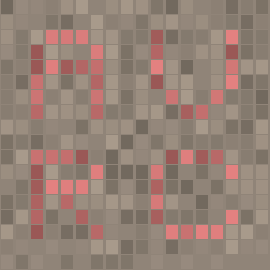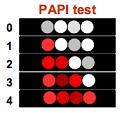The current situation can be quite frustrating. If you want to become a pilot you have to follow a complicated color vision test regulation. And even then most weak colorblind applicants are still rejected which seems to be an unfair decision.

Because of the lack of reliable, standardised tests and the absence of information on the specific colour vision needs of professional flight crew, the UK Civil Aviation Authority supported by the US Federal Aviation Administration initiated this study.
A team around Prof Barbur from the Applied Vision Research Center in London was mandated to find the minimum color vision requirements for modern flight crew, and a new color assessment and diagnosis test. This was the last part of the study after The Use of Colour Signals and the Assessment of Colour Vision Requirements in Aviation and a Task Analysis which included two operating case studies: the Airbus A321 and Boeing 757.
Dr Sally Evans, Chief Medical Officer at the CAA, says:
“The current diversity in colour vision testing methods and standards demonstrates the need to adopt more objective assessment techniques internationally. If the assessment methods and limits derived from this study were applied as minimum requirements for professional flight crew, 35 per cent of colour deficient applicants would be eligible for medical certification as a professional pilot. The CAA intends to promote this research internationally with a view to gaining acceptance of the CAD test and its incorporation in world-wide medical standards for pilots.”
This sounds very promising for all colorblind pilot applicants! So let us have a closer look at what this new color blindness test is all about and how they reached this new results.
Color Assessment & Diagnosis Test
The current procedures within JAA for pilot applicants are unsatisfactory for at least two reasons.
- There is no guarantee that the deutan subjects that pass secondary tests can cope with safety-critical, color-related tasks, since the severity of their color vision loss remains unquantified.
- Many color deficient subjects that can carry out such tasks safely fail the lantern tests and will not therefore be allowed to fly.
This findings and many detailed studies on color vision deficiency resulted in a new color blindness test, the color assessment & diagnosis test (CAD test). The subject’s task is to report the direction of motion of a colored square on a gray square background with dynamic luminance contrast noise. This new developed color vision test has shown in a broad study to be very accurate in identifying type and severity of one’s color blindness.
The subject’s color vision severity is measured in Standard Normal units (SN units). If your result would show a red-green threshold of 2 SN units this would mean, that you need a twice as strong color signal compared to a average standard CAD observer. This threshold can be quit different for deuteranomalous and protanomalous observers as a limit to pass the PAPI test. Details on this are shown in the conclusions.
PAPI Test
The Precision Approach Path Indicator (PAPI) was indicated as the most important, safety-critical task that relies largely on color vision. On this basis a PAPI simulator test was developed to quantify the severity of a pilots color vision deficiency which is still safe to fly. This simulator can be used in controlled laboratory environments.

The simulator reproduces both the photometric and the angular subtense of the real lights under demanding viewing conditions when the lights are viewed against a dark background. Since other color-related tasks such as seeing the color of the parking lights or the discrimination of runway, center-line, red and white lights are less demanding, it is assumed that the pilot will also be able to perform correctly these tasks.
The aim was to identify type and severity of color vision deficiency which cause problems with the PAPI test and correlate those results to the CAD test results. In principle, this approach should make it possible to recommend pass/fail limits based on the observer’s ability to carry out the most safety-critical and demanding PAPI task.
Principal conclusions
36% Deutans
30% Protans
35% Overall
The very promising results suggest that subjects with minimum color blindness that does not exceed 6 SN units for deuteranomalous observers and 12 SN units for protanomalous observers perform the PAPI test as well as normal trichromats. If these findings were adopted as pass/fail limits for pilots ~35% of color deficient applicants would be classed as safe to fly.
- When the ambient level of light adaptation is adequate, normal aging does not affect significantly either red-green or yellow-blue thresholds below 60 yrs of age.
- Analysis of PAPI results shows that the use of a modified white light results in significant, overall improvements in PAPI performance.The modified white is achieved simply by adding a color correction filter.
- 43 of the 77 deuteranomalous subjects failed the PAPI test. 29 out of the remaining 34 subjects that passed the PAPI test had CAD thresholds < 6 SN units.
- 20 of the 40 protanomalous subjects failed the PAPI test. 13 out of the remaining 20 subjects that passed the PAPI test had CAD thresholds < 12 SN units.
The study also concluded that the administration of the CAD test eliminates the need to use any other primary or secondary tests. When one includes normal trichromats, ~94% of all applicants will pass the so called fast-CAD screening test and be classified as safe to fly. This process is very efficient since the fast-CAD test is simple to carry out and takes less than 30 seconds to complete.
Official CAA news:
CAA research paves the way for more people with CVD to become pilots
CAA Paper 2009/04:
Minimum Colour Vision Requirements for Professional Flight Crew

This is fascinating, and wonderful news.
It is about time that a more intelligent approach was taken in colour vision testing. I hope that this new method gets the attention and funding it deserves.
Thanks Daniel.
hi sir, i wonder does cabin crew also need a perfect colour vision ? can a partial colour blind become a cabin crew?
Perfect colour vision is not required in order to qualify as cabin crew as the colour vision requirements are only needed by the pilots, so that they can safely distinguish various runway marker lights.
can a student with red&green deficiency join
-IAS OR CIVIL SERVICES
-ANY GOVT JOB
-HARYANA&OTHER MEDICAL SARVICES
-UPSC MED EXAMS
-MED PGs
-usmle
-force med services
-as doctor in med college?
PLZZ ALSO TELL ME ABOUT VARIOUS FOREIGN MED EXAMS 4 HIGHER STUDIES
& diff fields in which a med graduate can go i
I REQUEST U TO MAIL ME PLZZ NOT TO PUBLISH
my email -vipinnarwal@gmail.com plz mail me i hv passed mbbs nd i hv to think for my future career
it is the act to pass the color vision test for pharmaceuticals company
Hi Daniel,
Could you please advice where is the CAD test available, Is there any chance this test can be done in Canada or States?
Sean.